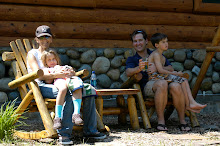Living in the Sierra Nevada Mountain Range is a delight, the ever-changing weather and ever-green trees make for a wild backdrop. For a flower and exotic plant-lover, Log Cabin livin' can be a challenge. The winters are cold with at least 5 to 6+ feet of snow from December through March, and the summers hot and dry.
My goal for these articles is to explore and experiment... and to see what works. I have a wonderful nursery in my area that has never steered me wrong - the Tahoe Tree Company in Tahoe City. I am also armed with my Sunset gardening bible - a tome thick and heavy with latin names, pictures and zone planting information.
I feel a need to contribute on this subject, because there isn't very much information about the growing zones my yard is firmly set in anywhere, and I hope I can help other people who love to plant... but have the high-altitude challenge.
The microclimates here put the log cabin firmly in the 1A (similar to Alaska and Northern Canada) and 6 zones for planting. I am using the 1A zone for my shade areas - snow and ice stay there much longer, and these areas don't get enough sun for things to grow very fast during the short season.
The Plot
There is an acre of land that I have worked for the last 8 years, and it is finally coming into it's own. We have owned the log cabin for 10 years as a vacation home, but only just moved into it permanently last June, 2008, realizing a dream that my family has had since we bought the place!
I have a wildflower meadow of Shasta Daisies, Black-eyed Susans and wild grasses that fulfilled it's potential last year after 7 years of growing, freezing and growing. There is the gorgeous sunny planter full of day lilies, daisies of all sorts and colors, lavender and bulbs that wraps around a large deck, part of my house, and surrounds 75% of my hot tub. Neither of these areas needs any help, they grow back themselves every year, get plenty of sun and require very little care other than deadheading once a month.
The majority of my yard was a labor of love until last summer, all I had to do was watch it grow, bloom and flourish! The rest of our acreage is forest, pines, manzanita, mules-ears, wild lupin and various ground covers that grow naturally here at Lake Tahoe.
The Challenges
My challenge is 80 feet long, 5 to 7 feet wide, north-facing, and 90% in the shade... the planter bed that extends the length of my log cabin at the front of the house. I also have a large front porch area that is shaded by the 2nd story... but lovely to sit on during the hot, dry summer days - and even lovelier if sprouting gorgeous plants and flowers... I would hope!
:The challenge of high-altitude mountain gardening is two-fold, truthfully
- The log cabin rests at 6,500 feet above sea level
- The growing season here is short - and I am lazy. While things start to sprout late-April to early-May, the full potential of the plants is not realized until the end of June. Everything goes to seed in late August, the sprinklers are turned off at the beginning of October when the nights start going into the freezing temps. I want to plant things that grow back so I don't have to do this every year, over and over again (that is the lazy part coming out).
- Any new planting should not take place until the end of May, 1st week of June as it does still snow or rain & freeze at night some years. You can have a 75 degree week, and then a 40 degree week, with temps into the 30's at night into May.
- The deer, rabbits and chipmunks that run rampant in the forest (it's a veritable Bambi movie here) love to eat... and this limits a gardener's variety of plants, because they need to be plants that don't get eaten! We love our herd of rabbits that lives under the boulder in our back yard, and the family of deer that traipse through nightly in the summer and fall.
The Porch: Pot Farming
For my front porch, I am willing to become an avid pot farmer. I envision myself sipping my wine in the late afternoon while my kids water a multitude of potted plants on the porch every day (it's very dry here). The plan for this space mostly consists of many different forms of fern, ivies, and a variety of bleeding-hearts, both hanging and shrubs for color.
I have 6 tea-rose pots that I keep in my master bath around my tub in the winter, but put on the slate porch steps in the summer. They get ample sun in the mornings there, but don't burn with the hot, dry afternoon sun because by 12:30-1pm, they are in the shade. I tried them on my back deck when we moved here last June, but they started to burn because the deck gets hit hard by the sun and is the hottest area in the yard.
I am currently researching my shade-plant pot farm, and my next article will most likely revolve around the research, plant types, soil and placement of these pots, since I can start them now inside and move them out in 3 weeks.
Part of my porch exploration is finding out if the perennial shade plants I planted last year (about 7 pots) grow back. I am starting my experiment by putting them on the back deck in the sun to start them off and watering them... we'll see if they come back!
Bedtime Stories
The 80-foot bed is still covered in ice and snow. Well, about 60 feet of it is. I have been shoveling off the snow to wake the plants up, and so I can see where I need to plant my permanent shade garden. But that is quite an effort, and some of it will just have to melt naturally... like where the 2000 pound icicles and ice dams fell off the roof and are sitting, waiting for a ray of sun, which they will not get for another month.
For this bed, starting some plants from seed and some from the nursery is the plan. The following is what I currently have in the bed:
- Spirea - a shrub that does alright - not great, but alright - in the shade, and is deer-proof. It has a nice lime-green to yellow leaf and adds color to a veritable sea of green
- Lupin - needs lots of water, but grows like a weed
- Columbine
- Foxglove
- Coneflower, and Day Lilies and Coreopsis at the ends of the planter that get all-day sun.
I will fill in the very large blanks in this planter with the following types of deer-resistant shade plants, concentrating on the ability of the plant to add color even if it is not a blooming variety:
- Marmalade heuchera - small maple-shaped leaves, but pale orange-to-amber colored leaves, small bush, 12 to 18 inches high
- Plum Pudding heuchera - light plum-colored leaves, 18 to 20 inches high
- Helebores - 14 to 20 inches tall, flowering
- Frageria - wild strawberry ground cover
- Ferns
Stepping Stones:
Planting for the future is a long-term, visionary process. The seed-plants I start this year may not realize their potential for several years after establishment. The potted variety, though perennial, may not grow back every year due to the harsh environs of my yard.
Experimenting in relatively new environment to create a haven for the future is what I am concentrating on... and I hope you enjoy the process with me!
My future articles will most likely cover the following subjects, and please let me know if you have any requests, as I love to experiment successfully in my yard!
- Shady Porch Pot Farming: This May!
- Hot, Dry & Baking: Pot Farming in the Sun
- The Tree Project: Will Willows work where I live? Pot Farming or In the Ground?
- Snow and Grass: Getting it Back, Green and Healthy
- Eating Ambience: Creating a Deck Dining Experience
- A Decked Veggie Garden: Experimenting with Veggie Pot Farming in Deer Country
- Shade Gardens: The Aftermath of Planting: How did it work?
Happy Diggin!










Hi Cec,
ReplyDeleteI found this fun article about some challenges for a gardener who relocated to Alaska; facing different issues, but may have some ideas.
http://www.juneauempire.com/stories/072508/nei_309624417.shtml